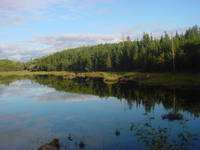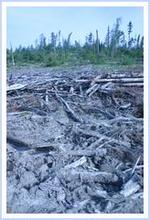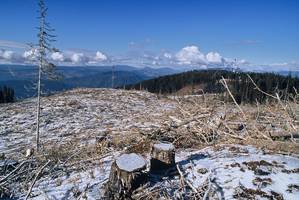Learn more about the ecological impacts of logging on Grassy Narrows' territory, and Canada's Boreal Forest.
- Grassy Narrows Territory
- Whiskey Jack Forest Management Unit
- Endangered Species and Caribou
- Canada's Boreal Forest
Grassy Narrows Territory
 Grassy Narrows territory occupies approximately 4,000 square kilometers within the Boreal Forest.
Grassy Narrows territory occupies approximately 4,000 square kilometers within the Boreal Forest.
Their territory consists of many lakes and rivers with the water flowing west, and eventually into the Arctic watershed. The forest is abundant with different types of wildlife: moose, deer, martens, rabbits, beaver, foxes, wolves, bears, eagles, and various birds. Local medicinal plants are known and used by the Grassy Narrows’ people, including treatments for diabetes, heart, sterility and skin problems.
Grassy Narrows’ traditional territory falls under forest management units that are unilaterally allocated and defined by the Ontario Government as the Whiskey Jack Forest. Approximately 50% of Grassy Narrows’ land has been logged.
Using highly mechanized industrial techniques, giant logging corporations create massive clear-cuts virtually overnight. These clear-cuts destroy trap lines, eliminate berry and medicine patches, damage the soils, and disrupt wildlife populations and game animals, including woodland caribou and pine martin. Rather than allowing natural regeneration, Weyerhaeuser scars the land, aerially spraying herbicides, and re-planting ecologically barren monoculture tree plantations.
Whiskey Jack Forest Management Plan
 Much of the Whiskey Jack Forest is in a young, fragmented state, having been recently disturbed by large amounts of fire, wind damage, road building, and logging. Over the objection of Grassy Narrows, the Ontario government licensed Abitibi Corporation to log on Whiskey Jack Management Unit until 2024. Weyerhaeuser’s Trus Joist mill in Kenora, Ontario, uses approximately 42 percent of the wood cut from the Whiskey Jack Forest – 323,726 cubic meters per year. The remaining wood goes to the Abitibi Fort Francis Mill and the Kenora Forest Products Mill to be used for catalogues and books.
Much of the Whiskey Jack Forest is in a young, fragmented state, having been recently disturbed by large amounts of fire, wind damage, road building, and logging. Over the objection of Grassy Narrows, the Ontario government licensed Abitibi Corporation to log on Whiskey Jack Management Unit until 2024. Weyerhaeuser’s Trus Joist mill in Kenora, Ontario, uses approximately 42 percent of the wood cut from the Whiskey Jack Forest – 323,726 cubic meters per year. The remaining wood goes to the Abitibi Fort Francis Mill and the Kenora Forest Products Mill to be used for catalogues and books.
“The forest is in rough shape,” says Chris Henschel, Manager of Forest Certification at Canadian Parks and Wilderness Society [CPAWS]-Wildlands League. “Abitibi cut almost all of the woodland caribou habitat in the forest between 1999-2004 that was still there after earlier logging periods. I don’t know if the caribou – which is a threatened species – will survive here.” A recent report on the Whiskey Jack Forest completed by CPAWS found that:
- The current harvesting level cannot be sustained for even 20 years.
- The company’s estimate of available wood is based on unrealistic assumptions about how much the forest can produce each year.
- Harvest levels are too high to protect existing wildlife habitat, or to allow the restoration of degraded habitat conditions in the forest.
The Ontario Government and Abitibi should be focusing on restoring the forest, rather than trying to sustain the cut,” says Henschel.
Endangered Species and Caribou
The cumulative impacts of industrial logging are devastating to many species. When wilderness becomes a checkerboard of clearcuts the forested regions become like isolated islands, exposing forest interior species to predation and parasitism.
These islands of forest have limited capacity to support old-growth dependant species, such as the Caribou. In winter, Woodland Caribou relies on the lichen that grows on mature or old growth tree species, including Spruce, White Spruce and Tamarack. Consequently, as the caribou’s winter food source is logged, caribou population decline. The habitat of the caribou has been moving northward at 34 km per decade coinciding with the northern front of industrial logging. Outside some relatively small intact areas such as are found in Trout Lake, healthy woodland caribou populations are almost entirely restricted to areas of undeveloped northern boreal forest. In the last 110 years, the historic range of woodland caribou has been reduced by half in Ontario.
The fate of the caribou – a species that is extremely susceptible to forest ecosystem disturbance – could also become the fate of the 30 percent of North America's land birds, such as the American black duck, mallard, blue-winged teal and northern shoveller who rely on the Boreal Forest as their Spring-nursery breeding ground. Elusive predators are also threatened including wolves, lynx, and wolverine.
Canadian Boreal Forest
 The ecological devastation at Grassy Narrows is being replicated across the Boreal Forest and Canada. Roughly 13 times the size of California, the Boreal Forest stretches across North America from Alaska to the Atlantic Ocean, forming part of a “green halo” of forest that encircles the Earth just below the Arctic tundra. The Boreal, which was named after Boreas, the Greek god of the North Wind, comprises 25 percent of the planet’s remaining ancient forest. Some of the Boreal’s key environmental features include mitigating global warming: the thick layers of moss, soil and peat of the boreal are the world's largest terrestrial storehouse of organic carbon and play an enormous role in regulating the Earth's climate. Boreal wetlands also filter millions of gallons of water each day that fill our northern rivers, lakes, and streams.
The ecological devastation at Grassy Narrows is being replicated across the Boreal Forest and Canada. Roughly 13 times the size of California, the Boreal Forest stretches across North America from Alaska to the Atlantic Ocean, forming part of a “green halo” of forest that encircles the Earth just below the Arctic tundra. The Boreal, which was named after Boreas, the Greek god of the North Wind, comprises 25 percent of the planet’s remaining ancient forest. Some of the Boreal’s key environmental features include mitigating global warming: the thick layers of moss, soil and peat of the boreal are the world's largest terrestrial storehouse of organic carbon and play an enormous role in regulating the Earth's climate. Boreal wetlands also filter millions of gallons of water each day that fill our northern rivers, lakes, and streams.
The Boreal forest is under threat. Less than eight percent of the Boreal is protected, and approximately half has been designated for resource extraction by the Canadian government. Close to 650,000 hectares of Boreal forest are logged each year in Canada and the predominant method of cutting this forest is via clearcutting where most, if not all, of the trees are removed. Ninety percent of logging in Canada occurs within primary and old growth forests – forests of high biodiversity and wilderness value. The Canadian Government is the world’s largest exporter of timber, and the United States is the largest consumer of wood products from the Boreal, which is logged mostly to provide fiber for throwaway items such as junkmail catalogs, facial tissue, toilet paper, copy paper, magazines, and newspapers.
Read a report, Bringing Down the Boreal, that documents how U.S. consumption of forest products is destroying Canada’s endangered northern forests.




